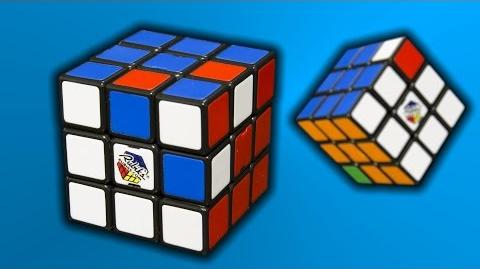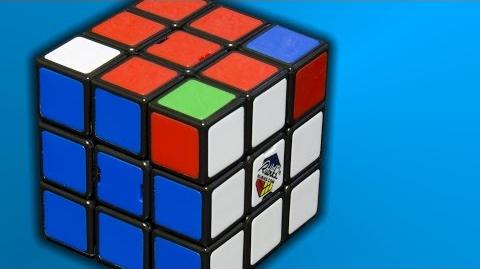This is basic Rubik's Cube theory.
The Basics[]
In a cube, there are 12 edges, 8 corners, and 6 centres. Therefore, there are three basic types of pieces in a puzzle cube; the edges, the corners, and the centres. The larger a cube is, the greater proportion of the cube's total surface pieces are centre pieces.
Orientation refers to the positioning of a piece relative to the cube as a whole. Orientation, however, is not the same as permutation. Permutation is how the pieces are arranged relative to each other, orientation refers to how the pieces are flipped or rotated while staying in their spot.
So, a spinning top would be constantly changing its orientation while not changing its permutation, a moving elevator would be changing its permutation while maintaining its orientation, and a bowling ball moving towards the pins would be changing its permutation and orientation.
Legal moves[]
Permutation[]
Every possible algorithm performs an even number of swaps.
As it turns out, every cube state reachable by legal moves can always be represented by an even number of swaps, and at the same time cannot be represented by an odd number of swaps (the two are mutually exclusive).
To understand why this is so, we need to realise that each legal move always performs the equivalent of an even number of swaps. No matter how many moves you perform, the number of accumulated swaps will therefore always remain even.
For example, consider the turning of one face by 90 degrees:
C1 E1 C2 C4 E4 C1 E4 E2 → E3 E1 C4 E3 C3 C3 E2 C2
The new corner state can be obtained via 3 swaps (swap C1/C4, swap C1/C3, swap C1/C2). Similarly, the new edge state can be obtained via 3 swaps. All together, this is 6 swaps, which is even. Therefore, no matter how many moves you perform, always an even number of swaps will have been performed.
Since exactly half of the conceivable permutations are even and the other half are odd, only half of the cube's permutations (ignoring orientation) are reachable by legal moves.
Edges[]
Every possible algorithm flips an even number of edges.
To establish this, it is necessary to decide on a frame of reference for correct edge orientation, regardless of where an edge is positioned on the cube. The most common frame of reference is to say that an edge in the wrong position has correct orientation if, when it is moved to its correct position using only left, right, top or bottom face turns, it would have correct orientation. Using this frame of reference, it is easy to see that any turn of the left, right, top or bottom faces will always flip zero edges, which is an even number. The only remaining faces are the front and back faces. In both of these cases, a 90 degree turn will flip all 4 edges, which is again an even number of flips. Therefore, it is never possible, using only legal turns, to flip an odd number of edges.
Corners[]
Every possible algorithm turns the corners so that the number of turns clockwise is divisible by 3.
Let's say that a corner has orientation "0" if it is twisted the correct way, it has an orientation of "1" if it is twisted clockwise, and it has an orientation of "-1" if it is twisted one step more clockwise (since this is the same as twisting anti-clockwise). Once again, to establish this, it is necessary to decide on a frame of reference for correct corner orientation. Notice that every corner either belongs to the top or bottom and therefore each corner has one of its stickers with either the colour of the top face or the colour of the bottom face. The most common frame of reference for correct corner orientation is to say that a corner has correct orientation if its top/bottom sticker is facing up or down. If it is facing in any other direction, then this corner is not correctly oriented. Using this frame of reference, it is easy to see that any twist of the top and bottom faces will not change the orientation of the corners, and therefore the total orientation will remain exactly divisible by 3. For any of the 4 sides, a 90 degree turn will twist two corners by orientation 1 and the other two corners by orientation -1. The total change in orientation is 1+1-1-1 = 0, hence no overall change. Therefore, no matter how many legal moves you make in a row, the net corner orientation will always remain the same.
Overall[]
For every 2*2*3=12 combinations, only 1 is actually reachable without taking the cube apart. (2 permutations, 2 edge flips, 3 corner twists.) Hence, in group theory, the cube is referred to as having 12 orbits.
Symmetry[]
Two different cases can be the same if the colors, reflection, or rotation is different, but everything else is the same.
Group Theory[]
Rubik's cube can be viewed as a mathematical group, where each element of the group is a permutation. As a group, it has the following properties:
- Closure
- If P1 and P2 are two permutations in the group, then P1P2 (i.e. the result of P1 followed by P2) is also a permutation in the same group
- Associativity
- Performing P1 followed by P2P3 is the same as performing P1P2 followed by P3.
- Identity
- There is a permutation in the group in which no pieces are moved.
- Inverse
- For each permutation in the group, there exists an inverse permutation which has the reverse effect.
Rubik's Cube also has a number of subgroups, each having these same 4 properties.
The property of groups that is perhaps most interesting to cubists is closure, which means that each operation within a particular group will take you to another element in the same group. This means that if you choose a subgroup and use only operations from that subgroup, then your cube will remain within that subgroup.
Conjugates and Commutators[]
A conjugate is in the form of XYX' where X' is the inverse of X. For instance, if Y is the sequence U2LR'F2RL', which cycles FD→FU→BU, and X is U2F (and X' is thus F'U2), XYX' will cycle FL→FU→FR.

Conjugates - Cube Theory 101
A video by RedKB on conjugates.
A commutator is in the form of XYX'Y'. For instance (as shown in the video below), if X is R'D'R and Y is U', XYX'Y' will cycle LUF→FRD→FUR.

Commutators - Cube Theory 101
A video by RedKB on commutators.